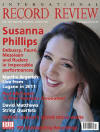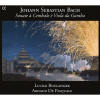Texte paru dans: / Appeared in:
*

International Record Review - (07- 08/2012)
Pour
s'abonner / Subscription information
Alpha 161

3760014191619
Consultez toutes les évaluations recensées pour ce cd
~~~~ Reach all the evaluations located for this CD
Abridged version:
While Bach was by no means the most prolific composer for the viola da gamba, or the one who wrote most idiomatically, his three sonatas for gamba and Harpsichord are the best known and among the greatest ever written for that most noble instrument.
This is not just because he was Bach and therefore everything he wrote in every genre must be considered superior to the works of his contemporaries. There is no doubt that his handful of works for solo lute, for example, are not equal to the best works by his friend Weiss. No, I suspect the reason that the three gamba sonatas are so much more popular than the many fine gamba compositions by Marais, for example, is that Bach’s works feature obbligato harpsichord — and no one surpassed Bach in writing for that instrument. The standard gamba sonata or suite has basso continuo only, but, as also shown in his great violin and flute sonatas, Bach loved the richness of the true trio sonata texture that came with writing an obbligato keyboard part. Some other composers such as Telemann employed the same technique occasionally, but they produced nothing remotely in the same class as the Bach sonatas.
....
On this recording, Boulanger is playing modem copy of a seven-string instrument made by Joachim Tielke in 1699, while her partner plays a copy of a Silbermann instrument from Bach’s time made in 1979 by Philippe Humeau (who also contributes an essay on the instrument). To supplement the three sonatas, which make rather short fare for a CD, the musicians play their own transcription of one of Bach’s sonatas for violin and continuo, which works very well indeed on the gamba. De Pasquale also plays the dazzling Toccata in C minor, BWV9I I with an almost hypnotic strength.
In her short essay, Boulanger explains that they chose to play Bach’s music on two typically German instruments ‘possessing both clarity of articulation and warmth of timbre’. These are exactly the qualities, among others, to be found in the performances of Boulanger and De Pasquale. I own a dozen or so recordings of the Bach gamba sonatas, but none, I think, that surpasses these for musical and intellectual lucidity. There is a crisp, newly minted quality to their performances that gives them something well out of the ordinary. Many years ago, I read a statement by one of the pioneers of Early Music performance (I can’t remember who — it may have been the lutenist Toyohiko Satoh) that sometimes one should ‘hold the note as long as possible ... but not too long’. This may sound like pretentious piffle, but it fairly describes how Boulanger plays the final notes of some phrases in the sonatas. Just when it seems she will draw out the line to the point of self-indulgence, she lifts her bow; the sense of tension and release is profoundly satisfying. Marvellous! The musicians’ enormous talents and musicality are complemented by a sound recording in a ravishing acoustic by the incomparable Alpha team. In a word: outstanding.
Cliquez l'un ou l'autre
bouton pour découvrir bien d'autres critiques de CD
Click either button for many other reviews


